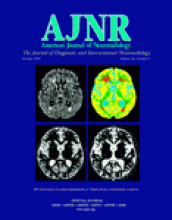Abstract
BACKGROUND AND PURPOSE: Because of their invasive nature, high-grade glial tumors are uniformly fatal. The purpose of this study was to quantify MR imaging-occult, glial tumor infiltration beyond its radiologic margin through its consequent neuronal cell damage, assessed by the global concentration decline of the neuronal marker N-acetylaspartate (NAA).
METHODS: Seventeen patients (10 men; median age, 39 years; age range, 23–79 years) with radiologically suspected (later pathologically confirmed) supratentorial glial neoplasms, and 17 age- and sex-matched controls were studied. Their whole-brain NAA (WBNAA) amounts were obtained with proton MR spectroscopy: for patients on the day of surgery (n = 17), 1 day postsurgery (n = 15), and once for each control. To convert into concentrations, suitable for intersubject comparison, patients’ global NAA amounts were divided by their brain volumes segmented from MR imaging. Least squares regression was used to analyze the data.
RESULTS: Pre- and postoperative WBNAA (mean ± SD) of 9.2 ± 2.1 and 9.7 ± 1.8 mmol/L, respectively, in patients were indistinguishable (P = .369) but significantly lower than in controls (12.5 ± 1.4 mmol/L). Mean resected tumor size (n = 15) was ∼3% of total brain volume.
CONCLUSION: The average 26% WBNAA deficit in the patients, which persisted following surgical resection, cannot be explained merely by depletion within the ∼3% MR imaging-visible tumor volume or an age-dependent effect. Although there could be several possible causes of such widespread decline—perineuronal satellitosis, neuronal deafferentation, Wallerian and retrograde degeneration, vasogenic edema, functional diaschisis, secondary vascular changes—most are a direct or indirect reflection of extensive, MR imaging-occult, microscopic tumor cell infiltration, diffusely throughout the otherwise “normal-appearing” brain.
- Copyright © American Society of Neuroradiology












